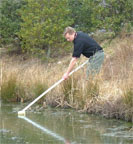USM Environmental Sustainability and
Climate Change Initiative
Climate Change Definitions
Carbon
footprint:
a measure of the amount of carbon dioxide (CO2 ) and
other green house gases (GHGs) associated with a particular activity. A carbon
footprint is often expressed as tons of carbon dioxide or tons of carbon
emitted, usually on a yearly basis. There are many versions of calculators
available to obtain a carbon footprint.
Carbon
neutrality:
The process of offsetting carbon-producing activities with those that either
reduce or capture carbon in order to credibly neutralize the net amount of
carbon released in the atmosphere from a particular activity.
Carbon
emissions trading (Cap- and- Trade Program): An administrative approach to control
emissions by setting an emissions cap for larger electric generating facilities
while creating a market with other participating states to trade emissions
permits (allowances.) The State of
Maryland recently joined nine other states in the Northeast and Mid-Atlantic by
signing on to the Regional Greenhouse Gas Initiative (RGGI), a cooperative
effort to design a regional cap-and trade program. The RGGI multi-state
cap-and-trade program will start in 2009 and include coal-fired, oil-fired and
gas-fired electric generating units with a capacity of at least 25 MW.
|

USM Environmental Sustainability and Climate Change Initiative
|
Greenhouse Gas (GHG): the
primary gases (both naturally existing and man-made) that contribute to global
warming by trapping more energy in the earth's atmosphere than would occur in
their absence. GHGs covered by the Kyoto Protocol are carbon dioxide, methane,
nitrous oxide, sulfur hexafluoride, hydrofluorocarbons and perfluorocarbons.
The other powerful GHGs are chlorofluorocarbons which are regulated separately
due to ozone depletion and water vapor, which cannot be directly influenced by
humans.
Greenhouse Gas Inventory (GGI): an
accounting of the amounts and sources of emissions of greenhouse gases that are
attributable to the existence and operations of an institution. This term is
often used interchangeably with carbon dioxide footprint or carbon footprint.
The major emission source categories are on-campus energy production, purchased
electricity, transportation (fleet vehicles, business air travel and faculty,
staff and student commuting), waste, agriculture and refrigerants.
Leadership in
Energy and Environmental Design (LEED): a nationally accepted benchmark
developed by the U.S. Green Building Council for the design, construction, and
operation of high performance green buildings.
LEED includes design criteria for new buildings and existing building
renovations.
Offsetting: A way of compensating for
the emissions produced with an equivalent carbon dioxide saving. An example of
this is the purchase of carbon offset credits from emission reduction projects
somewhere in the world.
Renewable
Energy Credits (RECs): Renewable Energy Credits (RECs) are a commodity created by an
environmentally friendly power generating facility, above and beyond the power
produced. Producers of "green" power can sell a REC to another party who requires
the credit for reasons ranging from improving corporate image to satisfying
regulatory compliance. When RECs are
traded, the entity purchasing the REC gains the right to claim the
environmental benefits.
Sustainability:
the ability to achieve continuing economic
prosperity while protecting the natural systems of the plant and providing a
high quality of life for its people. (U.S. EPA). Meeting the needs of the
present without compromising the ability of future generations to meet their
needs (Brundtland, 1987.)
Sustainability (university): the
development of a process or management system that helps to create a vibrant
campus economy and high quality of life while respecting the need to sustain
natural resources and protect the environment. Sustainable programs are those
that result from an institution's commitment to environmental, social and
economic health, or the "triple bottom line." Sustainability has institutional
and individual applicability, and is usually a balancing act. (Vanderbilt
University, 2007)
Sustainable: using methods, systems and
materials that won't deplete resources or harm natural cycles. (Rosenbaum, 1993)
Sustainable
development: applies
to many disciplines, including environment, economic development, food
production, energy and social organization. (The
Dantes Project)
Please send your ideas and comments regarding campus
sustainability to green@usmd.edu
Prepared by
the University of Maryland College Park Sustainability Office, 10/9/07
